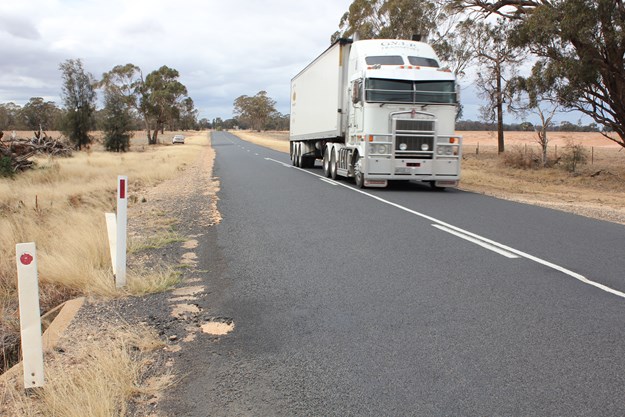The Newell Highway, one of eastern Australia’s most important freight arteries, is getting some big-money bypass operations and upgrades. However, north-south trucking might continue taking a detour – especially when the Inland Rail opens for business...
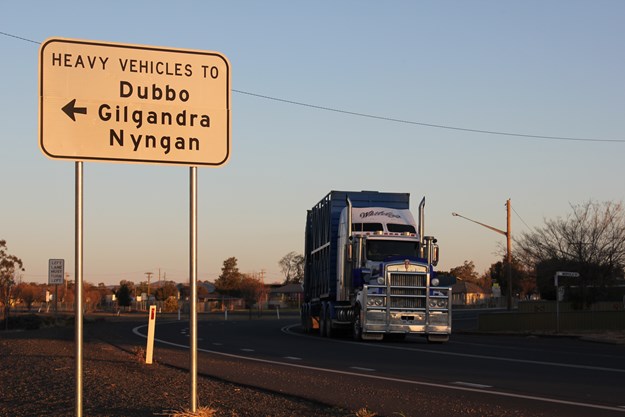 |
|
A truck coming off the Narromine heavy vehicle route and heading towards Condoblin
|
Narromine is a nice little town on the banks of the Macquarie River, half an hour to the west of Dubbo in western NSW. It’s probably best known for producing legendary Test cricketer Glenn McGrath.
The small shire of less than 7,000 people is also becoming increasingly well-known in the trucking industry for something else: as part of a de-facto 100km stretch of the Newell Highway.
The Newell is a national highway that runs for more than 1,000km from the Murray River at Tocumwal to the Queensland border at Goondiwindi, and it’s Australia’s third largest freight corridor, behind the Hume and Pacific Highways.
It’s the main route for trucks travelling between Victoria and Queensland, and forms a north-south spine for countless other highways and roads in regional NSW.
The federal and NSW governments between them have committed more than $1.2 billion over several years to improving the Newell, including $200 million for flood-proofing between West Wyalong and Forbes, and $170 million for a bypass of Parkes, which will allow trucks to avoid two rail level crossings.
Bypasses are also planned for Boggabilla and Coonabarabran. More than 30 overtaking lanes are in the process of being built, numerous metre-wide centre line spaces and wide shoulders are going in, and heavy duty pavement will be laid between Narrabri and Moree.
Local woes
Trouble is, to avoid a big bottleneck on the ever-improving route – the city of Dubbo – an estimated 300 trucks a day are already turning off the Newell and using some pretty ordinary stretches of local council road to then rumble through residential streets in Narromine. That Tomingley-Eumungerie Road was only opened up to B-doubles and road trains earlier this decade, and at about the same time trucks were diverted from the main street in Narromine.
“Narromine shire is subsidising the north-south freight route because we pay all the costs of traffic movement on our local roads,” laments Narromine Shire Mayor Craig Davies.
Not only that, but many local townsfolk and four schools are copping unacceptable noise and safety risks.
And Davies fears the situation is about to get worse. When major road and bridge works get underway in nearby Dubbo in a year or two, the Narromine mayor expects many more trucks will traverse his little shire and town for six months or more.
And he fears that could be just the start. When the $10 billion Inland Rail opens in 2025, he reckons many trucks won’t want to risk getting caught waiting for trains to cut the Newell at two level crossings – one at Forbes and one further north at Tichborne.
“They will all take 10–12 minutes each to cross when a train is in the vicinity,” Davies has been told by the Australian Rail Track Corporation. “What truckie will run that risk with eight trains operating a day initially and building to 18 by 2036? That doesn’t include the private logistics operators’ own locomotives.
“This will impact my shire like nothing before and there will be no funding because it will have all been spent at Parkes. The bypass at Parkes becomes a waste of money because the majority of trucks will no longer use the Newell.”
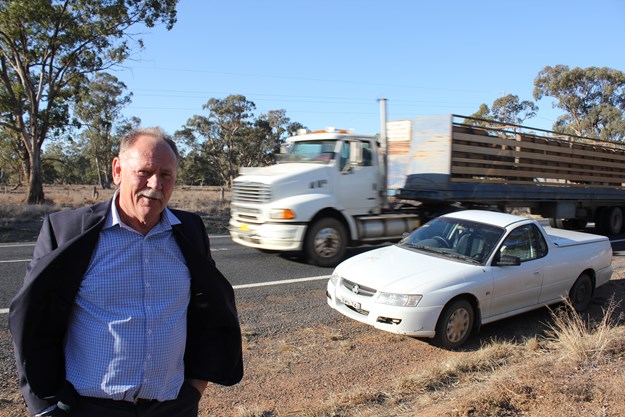 |
|
Narromine Shire’s Craig Davies and his mayoral ute where a massive Inland Rail bridge is expected to be built near town
|
Knowing a lot of trucking operators, Davies fears this Forbes rail crossing situation will create the “very strong possibility” that most of the trucks on the Newell will take a massive rat-run on local council roads – beginning way back at West Wyalong and heading through Condoblin and Narromine and coming back onto the Newell at Eumungerie just south of Gilgandra. And vice versa from the northern end.
“If that’s the case, our heavy vehicle numbers will increase from around 300 a day to potentially 1,100 to 1,300 a day and that’s something that as a shire we won’t accept.”
Many vertical runners are already using Condoblin to go even further west, coming out on the Newell at Gilgrandra (and some even at Narrabri).
The current main rat-run from Tomingley or Eumungerie through Narromine is planned to have a new level crossing involving a new section of Inland Rail just south of town, which Davies rates a “disaster waiting to happen” and “something we can’t tolerate”.
At that intersection he wants trucks to have the option of bypassing Narromine using the same giant rail bridge planned just east of town to cross the east-west rail line, Mitchell Highway and Macquarie River all at once. Or he wants a separate trucks bypass on the western side of town.
He realises huge federal and/or state dollars would be involved in these ideal scenarios, but can’t even apply for state funding to upgrade the current local shire roads until he gets more certainty on plans from Inland Rail and the NSW Government and expert estimates of traffic flows in five years’ time.
In the meantime, upkeep of the Narromine Shire “detour” is costing his ratepayers $600,000 every year, and he has asked the state government to take back this stretch of road, which was “given” to them nearly a decade ago along with a one-off maintenance fee of $400,000.
“That was it. ‘Here’s the road, here’s 400 grand.’ That fixed the potholes in the first year,” says Davies. “When you look at the amount of funding that shires of this nature get as opposed to the regional centres, it’s disgraceful.
 |
|
The problematic roundabout in question
|
Working together
Don’t get Davies wrong – he says the Inland Rail should be a huge boost for his shire, and that there is already strong private sector interest in a possible freight hub for the town, amongst other possible major developments.
“Inland Rail will be a once in a lifetime opportunity for Narromine, which is on the confluence of major highways and freight routes. It brings opportunities for us to value-add to agricultural products that we’ve never seen before.
“It also gives us rail access to every major port in Australia … The amount of investment that will occur in our shire in the next five years could be as much as three quarters of a billion dollars.”
Trucks are integral to all that of course, and Davies expects a lot more of them will need to come to the shire. There are already a lot of trucks travelling east-west along the Mitchell Highway.
And Inland Rail won’t lead to a lessening of trucks travelling between Victoria and Queensland, even though each double-stacked superfreighter nearly two kilometres long will carry the equivalent of more than 100 B-doubles.
“They expect the truck numbers will still increase but not at the same rate that they would have without the trains,” says Davies.
Dodging traffic jams and the RMS
Davies is a prominent member of the National Party locally, and so is Dubbo-based trucking industry stalwart John Morris. But they are on different sides of the “detour” debate.
Morris is the honorary co-ordinator of the Regional NSW High Productivity Road Transport Alliance. He’s against Narromine Shire becoming an official Dubbo bypass, and has been campaigning for two decades for a Dubbo “western distributor”, running close to the city via the airport as part of the Newell Highway.
“I don’t think the state government will fund two state roads that run parallel to each other 40 kilometres apart and 100 kilometres long,” Morris says.
But he agrees with Davies on the current reality that a lot of trucks are avoiding Dubbo and using Narromine, often saving time and fuel in the process.
That’s largely because of the infamous roundabout at the intersection of the Mitchell and Newell Highways right in Dubbo, which is already a city of more than 40,000 people and growing rapidly. Morris says that especially in the morning peak heading north, B-doubles can be banked up for a block waiting to take up both lanes to get through.
Morris says there is a second factor causing a lot of truckies to detour along the Tomingley-Eumungerie Road via Narromine: sometimes overzealous NSW Roads and Maritime Services officers are at the Brocklehurst pads when they are open, just north of Dubbo.
“Truck drivers need to feel that if they’re doing the right thing, they won’t be persecuted – and they’re persecuted more and more,” Morris says. “They should pull into a checking station, do the usual logbook and weigh inspections and be confident of coming out the other end not losing half their pay for the week on something minor. It doesn’t happen often but it happens often enough that they will deliberately bypass the pads that are working.”
In fact there are another two sets of pads on the Newell between West Wyalong and Brocklehurst. So some trucks are already detouring through Narromine via Condoblin to avoid those, whether they have something to hide or not.
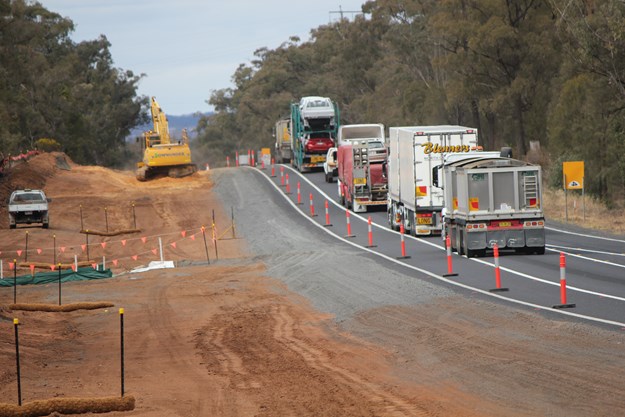 |
|
Good work: an overtaking lane being built on the Newell between Dubbo and Eumungerie
|
Dubbo bridge controversy
The NSW Government’s position on the Narromine detour/Dubbo bypass debate seems unclear.
On one hand, government MPs have referred to Narromine as a “natural bypass” of Dubbo; on the other, they also favour a Newell Highway bypass much closer to the city, but say it won’t be needed until 2040 or later.
However, planning is advanced for nearly $200 million worth of road and bridge works in Dubbo itself, to give the city a second flood-proof river crossing and ease congestion for both cars and trucks using the Newell through Dubbo. These works include replacing the notorious Newell roundabout with traffic lights and more lanes.
The associated $140 million River Street bridge would mean that rather than crossing the river near the CBD as at present, trucks would continue two kilometres further north on a new road on the western side of the river before crossing over. This means they would be able to avoid the second roundabout and sharp left-hander at a set of lights that they currently have to contend with.
The new bridge would also directly serve local traffic (including ambulances) accessing the expanding north-eastern health and educational precinct around Dubbo Base Hospital, Dubbo College Senior Campus, and two university campuses. It would also provide for future growth in the north-west.
However, Morris, the majority of Dubbo regional councillors, some big local trucking companies and, according to a council survey, the majority of residents, don’t want the River St bridge.
Instead they want a new high-level bridge three kilometres further north of town, on Troy Bridge Road, which they say could become the first stage of a complete western bypass of Dubbo. That bridge and bypass would be far more expensive than the current plan, with Morris estimating about $300 million (and Davies $400 million).
The RMS says more three quarters of the trucks on the Newell at Dubbo want to go into its industrial areas, which include the saleyards and abattoirs. But Morris says the RMS has not publicly released its traffic surveys and reckons they haven’t accounted for the trucks already “dodging” Dubbo via Narromine, or those already using Troy Bridge Road.
Official responses
The NSW Government’s 2015 Newell Highway Corridor Strategy says at one point: “The longer term vision is to remove rail level crossings in the corridor.”
However, in a statement to Owner//Driver, Transport for NSW said: “The decision about whether a level crossing is deemed necessary is the responsibility of the ARTC (Australian Rail Track Corporation) after assessing the rail crossing safety and delay impacts and consulting with the relevant road authority.”
The ARTC confirmed to Owner//Driver Davies’ understanding that no separation of trains and traffic is planned in the Forbes area.
On the Dubbo/Narromine transit issues the TfNSW statement said: “The NSW government is committed to improving access through Dubbo, with plans under way to construct a new bridge at River Street.
“This bridge will provide a second river crossing and more consistent access to North Dubbo with the bridge able to withstand a 1 in 100 year flood event.
“The NSW government has no plans for a bypass of Dubbo via Narromine.
“Narromine Council has created a heavy vehicle detour route around the main street of Narromine. The detour route provides benefit to east-west traffic as well as north-south. There are no further plans by NSW government to bypass Narromine.”
On Morris’ view of sometimes pedantic RMS mobile checking station inspectors, the statement says: “Transport for NSW … attempts to achieve voluntary compliance in the first instance through education and in some cases warnings, unless the offences are so serious that infringements or prosecution is warranted.”
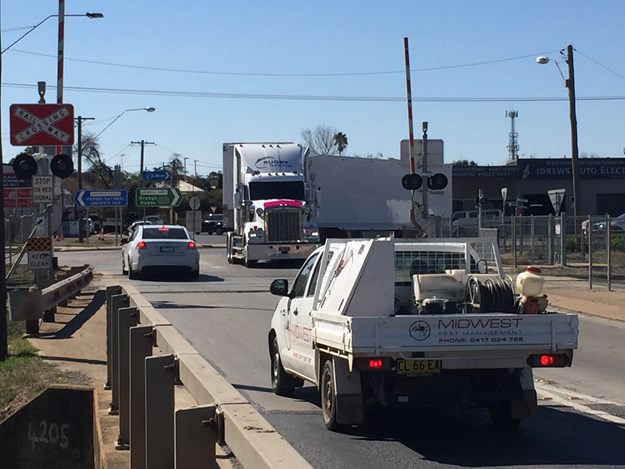 |
|
Enemy of the long distance truck driver: a level crossing at Parkes which is going to be bypassed
|


